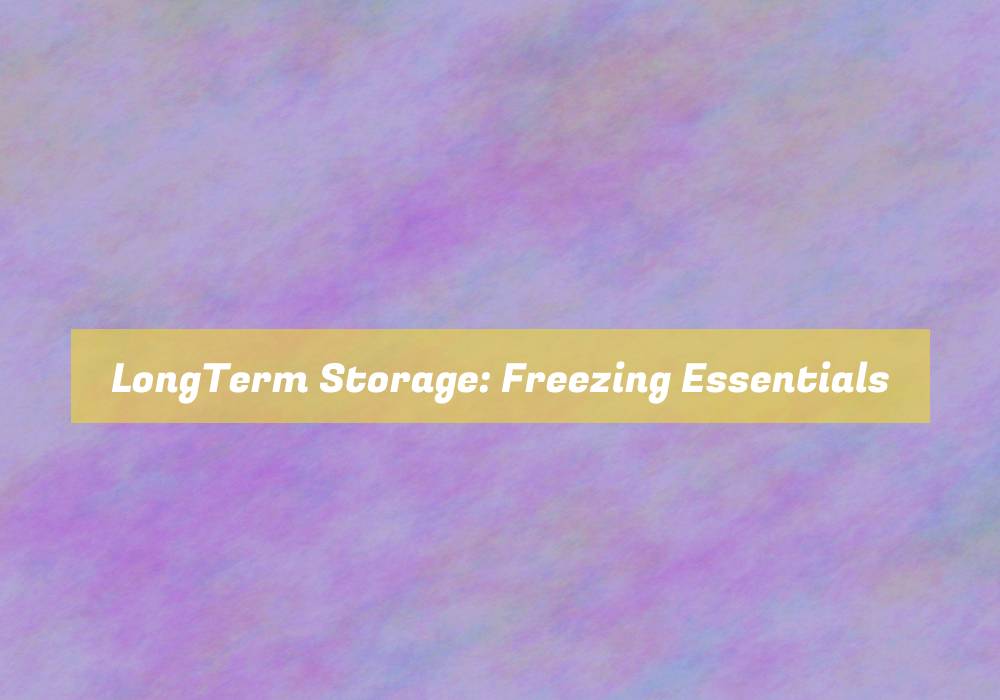LongTerm Storage: Freezing Essentials
You probably think you know how to freeze food, but did you know thereG??s a lot more to it than just throwing items in the freezer?
Proper long-term storage of essentials involves specific techniques and strategies that can make a significant difference in the quality and longevity of your frozen goods.
By paying attention to the details and implementing the right methods, you can ensure that your frozen essentials maintain their freshness and flavor for an extended period.
Whether youG??re a meal prepper, a bulk shopper, or simply want to make the most of seasonal produce, understanding the nuances of freezing essentials is essential for avoiding food waste and always having the ingredients you need on hand.
Proper Packaging for Freezing Essentials
To ensure the best results when freezing essentials, itG??s crucial to use proper packaging techniques.
Start by choosing packaging specifically designed for freezing. Look for heavy-duty plastic bags or containers that are labeled as freezer-safe.
When packing items for the freezer, be sure to remove as much air as possible from the packaging. Air can cause freezer burn, which can affect the quality and taste of your essentials. For items like fruits and vegetables, consider using a vacuum sealer to remove excess air and ensure a tight seal.
Additionally, be mindful of portion sizes when packaging essentials for the freezer. Dividing items into smaller portions can make it easier to defrost only what you need, reducing waste and ensuring that the remaining portions stay fresh.
Labeling your packages with the contents and date can help you keep track of whatG??s in your freezer and ensure that you use items before they lose their quality.
Labeling Techniques for Long-Term Storage
When organizing your frozen essentials for long-term storage, mastering effective labeling techniques is essential for keeping track of your items and ensuring their quality over time.
The first step is to use a permanent marker to write the contents and date on the packaging. Be specific when labeling, including details like the type of food, quantity, and any preparation instructions.
Consider using color-coded labels or stickers to easily identify different categories of items, such as meats, vegetables, and prepared meals. Utilize freezer-safe labels or masking tape to prevent smudging or fading over time.
Place the labels in a prominent and easily visible location on the packaging to quickly identify the contents without having to rummage through the freezer.
Additionally, create a list of the items and their corresponding location in the freezer, and attach it to the door or nearby surface. This will streamline the retrieval process and help you keep track of inventory.
Maximizing Freshness and Flavor
Maximize the freshness and flavor of your frozen essentials by properly sealing them in airtight packaging before placing them in the freezer. This step is crucial in preserving the quality of your food items.
When packing your essentials, ensure that thereG??s minimal air inside the packaging to prevent freezer burn and maintain optimal taste. Consider using vacuum-sealed bags or airtight containers to achieve the best results.
Furthermore, be mindful of the packaging material. For long-term storage, use heavy-duty freezer bags or containers specifically designed for freezing to prevent moisture loss and freezer burn. These specialized materials provide an extra layer of protection against the harsh conditions of the freezer, keeping your essentials tasting fresh for an extended period.
ItG??s also essential to remove as much excess air as possible from the packaging before sealing. This can be done by carefully pressing the air out of the bags or containers before sealing them shut.
Tips for Efficient Freezing Practices
Consider using a variety of freezing methods to efficiently preserve different types of food items.
For fruits and vegetables, the blanching method is effective in retaining their color, flavor, and nutrients. Simply immerse the produce in boiling water for a short time, then transfer them to an ice bath to halt the cooking process before freezing. This method also helps to preserve the texture of the produce.
When freezing meats, ensure theyG??re properly wrapped to prevent freezer burn. Vacuum-sealing or using airtight containers will help maintain the quality of the meat during storage. Additionally, itG??s important to label all frozen items with the date of freezing to keep track of their freshness and prevent food waste.
To save space in the freezer, consider using stackable containers or bags that can be easily organized. Remember to leave some space in the containers or bags for the food to expand as it freezes.
Conclusion
In conclusion, freezing essentials for long-term storage is a great way to preserve freshness and flavor. By properly packaging and labeling items, you can ensure they stay fresh and are easy to find when needed.
Remember to use efficient freezing practices to make the most of your freezer space. With these tips, youG??ll be able to enjoy your favorite foods even months down the road.
Happy freezing!







Your insights on freezing food truly resonate with me, especially given how pivotal proper storage techniques can be in maintaining the quality of our meals. I’ve always been a meal prepper, but I’ll admit that I used to take a more slapdash approach to freezing my food. My first experience with serious freezing mishaps came when I popped some fresh strawberries in a generic plastic bag and learned the hard way about freezer burn. It’s such a waste to see perfectly good food compromised when, as you’ve pointed out, it doesn’t have to be that way!
It sounds like you’ve had quite the journey with freezing food. I can relate to your experience with strawberries; freezer burn is a lesson many of us have learned the hard way. It’s interesting how something as simple as proper storage can significantly influence our meals. Once I started using vacuum-sealed bags, it was like a game changer for me. It not only keeps things fresher for longer but also helps with portion control when meal prepping.
It’s great to hear that you’re on the same page with the freezer challenges. Strawberries can be particularly tricky! It’s funny how we think we’re saving food by freezing it, only to open the bag later and find a sad, frosty version of what used to be vibrant fruit.
You hit the nail on the head about freezer burn! It’s like the enemy no one invited to the party. Those poor strawberries come out of the freezer looking like they’ve been through a rough bouncer at the nightclub. Vacuum-sealed bags really are a miracle, though—who knew we’d be living in the future with flavors preserved like time travel?
Your experience with freezing strawberries really highlights a common challenge many face when it comes to food storage. It’s surprising how something that seems so simple can lead to unexpected results. Freezer burn is a sneaky culprit, affecting not just the appearance but also the taste and texture of our food. It’s frustrating to open a bag and find those once-vibrant strawberries looking frosty and dry.
I can totally relate to your experience with the strawberries. It’s surprising how easily we can overlook the impact of proper storage on our food. I remember my own mishap with some herbs; I thought I could just toss them in a bag and forget about them. When I finally fished them out months later, they were basically dust. It’s frustrating, especially when you put so much effort into meal prepping.
You’re spot on with that herb saga. It’s shocking how a bag can turn into a mini tomb for our food. I had my own herb tragedy once—thought I’d be a kitchen hero and bought a whole bunch of fresh basil. I put it in the fridge, but somehow it went from vibrant green to an unrecognizable shade of “why-am-I-even-opening-this-bag.”
It’s interesting to hear about your strawberry mishap. Freezer burn really can sneak up on you, especially when you think you’re doing the right thing by tossing food in a bag. It highlights how easy it is to overlook proper techniques.
I completely understand what you mean about freezer burn sneaking up on you. It’s such a shame to open the freezer and find something that looked so promising turned into a frosty disappointment. I’ve definitely had my share of mishaps too, especially with fruits and veggies. It’s interesting to think about how much we take for granted those little steps in food preservation.